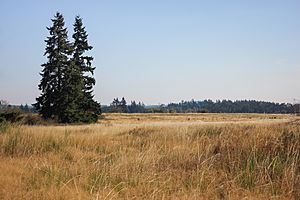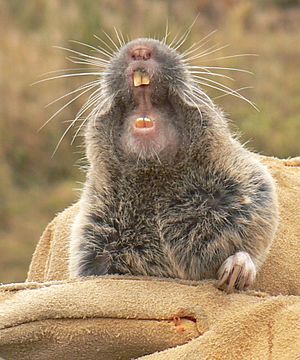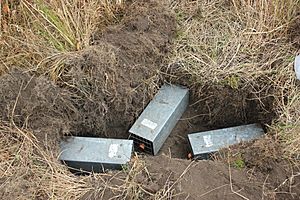Mazama pocket gopher facts for kids
Quick facts for kids Mazama pocket gopher |
|
|---|---|
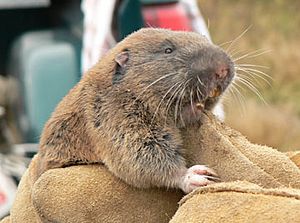 |
|
| Conservation status | |
| Scientific classification | |
| Genus: |
Thomomys
|
| Species: |
mazama
|
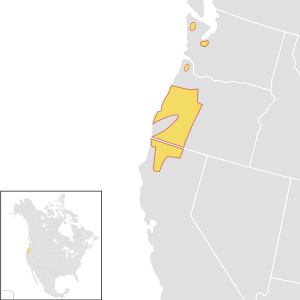 |
|
| Distribution of the Mazama pocket gopher | |
The Mazama pocket gopher (Thomomys mazama) is a small animal that lives underground. It is a type of smooth-toothed pocket gopher. You can find them only in the Pacific Northwest part of North America. Their home stretches from the coast of Washington, through Oregon, and into northern California.
Contents
About the Mazama Pocket Gopher
Mazama pocket gophers are usually light brown or black. Adult gophers are about 5 to 6 inches long. That's about the length of a pencil!
These gophers don't see very well. But they are amazing at digging! They have long claws and strong legs. This helps them make tunnels underground. They carry food and nesting stuff in special fur pouches on their bodies.
Mazama pocket gophers mostly eat plants. They love roots, tubers, and other plant parts. These gophers usually live alone. They only get together during mating season. A female gopher is pregnant for about 18 days. She usually has 3 or 4 babies in each litter. Most females have one litter per year, between March and June.
Their Role in Nature
Mazama pocket gophers are very important to the grassy areas where they live. They help the environment a lot. Each gopher can move a lot of soil every year. This helps the soil stay healthy.
Their digging also helps different kinds of plants grow. One study showed that plant variety was much higher where gophers lived. Their tunnels are also used by many other animals. Frogs, toads, small mammals, and lizards all use gopher burrows for shelter.
Where They Live
We don't know the exact number of Mazama pocket gophers. But we think there are more than 100,000 of them. Most of these gophers live in Oregon.
In Washington state, there are 27 known groups of gophers. Experts believe there are about 2,000 to 5,000 gophers in Washington. The state of Washington has listed the Mazama pocket gopher as a "threatened" species. This means they are at risk of disappearing.
Gophers in Washington
The Mazama pocket gopher in Washington has lost many of its homes. This is because their natural habitats have been built on. The biggest groups of gophers are now found in surprising places. These include areas around Fort Lewis and some local airports. Olympic National Park might also have a large group of them.
A study in 2005 said there were 6,000 gophers near Olympia airport. But some people think this study might not be completely accurate. It counted burrows, but didn't actually count the gophers themselves. The number of gophers can also change a lot. It goes up after babies are born and then drops later in the year. This is often because other animals hunt them.
Some types of Mazama pocket gophers in Washington are very rare. Two types are thought to be extinct (gone forever). Another type, Thomomys mazama douglasii, might also be extinct.
Keeping Them Safe
The state of Washington says the Mazama pocket gopher is a threatened species. This means they need protection. In 2012, the U.S. Fish and Wildlife Service also suggested listing them as threatened. This would protect four special types of Mazama pocket gophers. It would also protect the prairie lands where they live.
Sadly, 90-95% of their prairie homes have been lost in the last 150 years. People have tried to move gophers to new safe places. But about 90% of the gophers moved did not survive.
Sometimes, gophers are seen as a problem in Washington. This is because their digging can cause damage. They can break water pipes, harm farm animals, ruin crops, and weaken dams.
Protecting these gophers has been in the news. In 2013, Fox News reported on a large grant. Fort Lewis received $3.5 million to buy land for gopher habitat. This was at a time when some government workers were not getting paid. Before this, the Interior Secretary Sally Jewell said this step was important. She said it helps protect wildlife and military lands.
How to Prevent Damage
Gophers can damage farms and buildings by digging. They can also eat plants. To stop this, people can build special fences. These fences need to be at least 6 inches above the ground. They also need to go down into the ground for over 2 feet. Or they can go down until they hit hard rock. These fences are only a short-term solution.
Things like vibrating stakes or pinwheels usually don't scare gophers away. Other ways to control gophers exist. But since the Mazama pocket gopher is threatened in Washington, only ways that don't harm the gophers are allowed.
Their Family Tree
The Mazama pocket gopher gets its name from Mount Mazama. This was an ancient volcano in Oregon. It exploded to form Crater Lake. This is where the gopher was first discovered. Even though it's named after Mount Mazama, you won't find this gopher in Mazama, Washington.
Types of Mazama Pocket Gophers
Here are some of the different types (subspecies) of Mazama pocket gophers:
- †Thomomys mazama tacomensis - This type is now extinct.
- †Thomomys mazama louiei - This type is also believed to be extinct.
- Thomomys mazama couchi - This type is vulnerable, meaning it's at risk. It lives in the Puget Sound area.
- Thomomys mazama pugetensis - This type is also vulnerable and lives in the Puget Sound area.
- Thomomys mazama tumuli - This type is vulnerable and lives in the Puget Sound area.
- Thomomys mazama yelmensis - This type is vulnerable and lives in the Puget Sound area.




